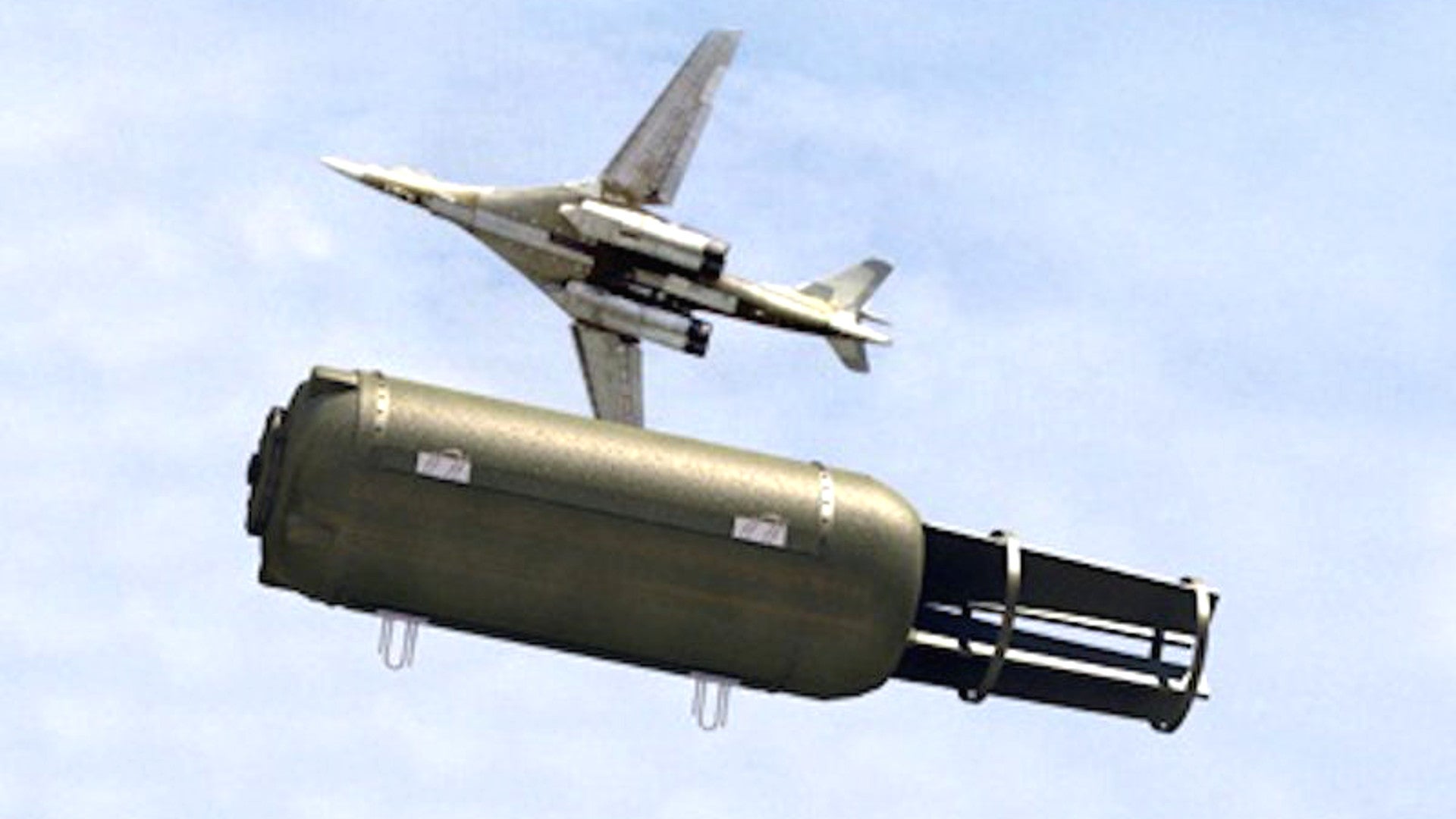A rumor has appeared on social media suggesting that Russia has dropped its most powerful non-nuclear bomb, nicknamed the Father of All Bombs, on ISIS terrorists
in Syria. If confirmed, this would be the first time Russia has employed this weapon, which is has otherwise revealed very little about, in combat.
On Sept. 7, 2017, posts appeared on Twitter alleging that witnesses and activists near the Syrian city of Deir ez-Zor, had seen the weapon in action.. As yet, though, there has been no reporting in English language Russian news outlets or an official statement from the Russian Ministry of Defense.
There are few concrete details about the FOAB, formally known as the Aviation Thermobaric Bomb of Increased Power (ATBIP), and almost no official pictures or video of the bomb – one Tweet even used a picture of a mockup of the Soviet hydrogen bomb Tsar Bomba instead. It apparently uses a high explosive filler boosted with a mixture of aluminium powder and ethylene oxide, components common to other known thermobaric weapons, to create the high-intensity blast and associated shockwave.
The Russians say the complete weapon weighs just over 14,000 pounds and can create a blast equivalent to 44 tons of TNT. This would make it lighter, but more devastating that than U.S. Air Force’s 22,000 pound GBU-43/B Mother of All Bombs (MOAB), which the Russians were clearly referencing with their own nickname.
“Tests show its effectiveness and capabilities are comparable to nuclear weapons,” Russian General Colonel Alexander Rukshin, then Deputy Chief of the country’s Armed Forces General Staff, said after the first field test on Sept. 11, 2007. “At the same time, the use of this weapon doesn’t damage or pollute the environment.”
Russia claims that the Tu-160 Blackjack super-sonic heavy bomber is the primary means to delivering this massive bomb, but that seems highly unlikely. Official film of the test is heavily edited to show a Tu-160’s bomb bay opening, before cutting abruptly to what looks like the bomb falling way straight out the back of different plane.

It is much more likely that an Il-76 cargo plane, or even the larger An-124, would carry the weapon to the target area and releases its out its rear cargo door like other air-dropped cargo. This is similar to the arrangement the U.S. Air Force uses to drop the GBU-43/B and had employed with the previous BLU-82/B Daisy Cutter.
Like the BLU-82/B the FOAB uses a parachute to slow its descent and allow the delivery aircraft to fly low and escape the blast. The Russians claim the bomb is guided by their own GLONASS satellite navigation system, similar to GPS, but this delivery profile strongly suggests the weapon is actually unguided.

Otherwise, the aircraft could drop it accurately while flying at a safe altitude and have no need for the parachute beyond possibly initially stabilizing the weapon in a downward orientation. The American MOAB, unlike the older Daisy Cutter, is GPS-guided and does not use a retarding parachute or other similar system.
The U.S. military employed the MOAB for the first time in combat in Afghanistan in April 2017 on a tunnel network occupied by members of ISIS’ franchise in the country, known as ISIS-Khorasan or ISIS-K. The main terrorist group in Syria and Iraq is also known to favor subterranean networks to escape air and artillery strikes and move around undetected, so it is possible that the Russians could have decided to use it near Deir ez-Zor for similar reasons.

In August 2017, the Syrian government claimed it had finally begun to link up with besieged government forces in a portion of the city, which ISIS has surrounded since April 2014. The regime of brutal dictator Bashar Al Assad officially declared the siege over on Sept. 5, 2017, but fighting in and around the city continued according to witnesses and activists in the country.
If the reports of the Russian air strike turn out to be true, it is also possible that dropping the FOAB was a message intended for another party. U.S.-supported Syrian rebels belonging to the Syrian Democratic Forces have been suggesting they are on the verge of beginning an offensive into Deir ez-Zor governorate, ostensibly to attack ISIS.

However, those operations could potentially put them in a position to eventually launch attacks against the Syrian government and its allies. The massive Russian strike could be seen as a warning to any anti-regime forces interested in moving into the area as ISIS falls back.
Regardless of whether or not the Russians have actually dropped a FOAB in Syria, the Kremlin has already decided to use the country as a proving ground to show off its latest weaponry, even if they’re poorly suited to the situation at hand. So, it’s very likely that if the FOAB is indeed operational, we could eventually see it used in the war-torn country.
Contact the author: joe@thedrive.com
